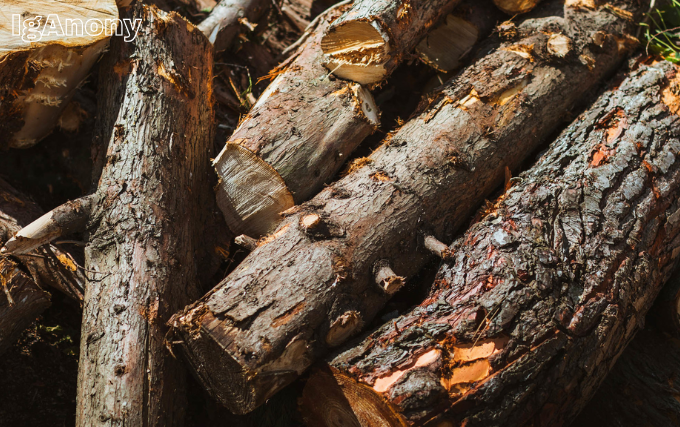Homeowners in the United States are looking for ways to heat their homes that are good for the planet. Hot-burn hardwood logs are becoming popular. They help reduce carbon footprint and keep homes warm.
People are interested in hot-burn hardwood logs because they are efficient and eco-friendly. These logs offer a greener way to heat homes. They promise to use less energy and produce fewer emissions.
To understand the benefits of hot-burn hardwood logs, we need to look at their unique features. We’ll compare them to traditional heating sources. This article will explore the eco-friendly aspects and practical uses of these logs.
We’ll discuss how hot-burn hardwood logs affect the carbon cycle and compare emissions. This will show why they are a good choice for those who want to heat their homes sustainably and efficiently.
Understanding the Basics of Hot-Burn Hardwood Logs
Hot-burn hardwood logs are a top choice for those who want efficient and eco-friendly heat. They are made to burn better than regular firewood. This makes them a great option for homes.
The main features of hot-burn hardwood logs are:
- Dense wood from the best hardwoods
- Dried and processed for top energy use
- Same size and moisture for best burning
- Less smoke when burning
Log makers pick trees like oak, hickory, and maple for their high heat. These trees have dense wood that burns well. The logs are made to have little moisture and lots of energy.
Choosing hot-burn hardwood logs brings many benefits:
- They burn longer than regular firewood
- Give steady heat
- Burn cleaner, which is better for the environment
- Easier to store and handle
Knowing how these logs work helps people choose the best heating for their homes. Hot-burn hardwood logs are a smart choice for those who care about efficiency, the planet, and good performance. You can source them from the best supplier in the UK , LektoWood fuels.
Environmental Impact of Traditional Heating Methods
Traditional heating methods have long harmed the environment. They use fossil fuels, which release a lot of carbon emissions. This greatly affects global climate change.
These methods also harm the environment in other ways. Unsustainable wood harvesting is a big problem. Many traditional heating methods burn wood inefficiently.
This leads to:
- High levels of particulate matter
- Contribution to deforestation
- Excessive carbon dioxide emissions
Hot-burn hardwood logs are a better choice. They use sustainable wood and burn efficiently. This reduces the environmental harm usually caused by wood burning.
The carbon footprint of old heating methods is huge. Fossil fuel systems release carbon into the air, speeding up global warming. But, hot-burn hardwood logs are better. They help manage forests and lower environmental strain.
More people want heating that’s good for the planet. Hot-burn hardwood logs are a smart choice. They help reduce environmental harm while keeping homes warm.
The Carbon Cycle and Sustainable Wood Heating
Understanding the carbon cycle is key to finding green heating options. Hot-burn hardwood logs are a big part of eco-friendly home heating. The carbon cycle is nature’s way of moving carbon around between the air, plants, and animals.
Wood heating with hot-burn hardwood logs is close to being carbon neutral. Trees take in carbon dioxide as they grow. When these logs are burned, they release this carbon back into the air. This makes wood heating almost carbon-free if done right.
- Trees capture carbon during growth
- Hot-burn hardwood logs release stored carbon when burned
- Sustainable forestry replaces harvested trees
Sustainable forestry keeps forests healthy and growing. For every tree cut down for logs, another is planted. This keeps the carbon cycle in balance. Wood heating becomes a green energy choice.
Choosing hot-burn hardwood logs cuts down on carbon emissions. This is better than using fossil fuels. The carbon cycle helps keep our planet healthy while warming our homes.
Heat Output and Efficiency of Hot-Burn Hardwood Logs
Hot-burn hardwood logs are a top choice for those who want the best warmth and efficiency. They are made to give off a lot of heat. This makes them perfect for anyone looking to heat their home well.
Several important factors affect the efficiency of hot-burn hardwood logs:
- Higher British Thermal Unit (BTU) rating compared to standard firewood
- Longer sustained burn times
- More consistent heat distribution
- Reduced moisture content for optimal burning
The logs’ efficiency comes from their special wood and how they are prepared. Woods like oak and maple burn slowly and give off a lot of heat. This means your home will stay warm for longer with these logs.
Studies show that hot-burn hardwood logs can give 25-30% more heat than regular firewood. This means you’ll use less fuel and save money on heating your home.
When picking hot-burn hardwood logs, it’s important to know what makes them special. Things like wood density, moisture, and how they are made affect how well they heat your home.
Comparing Emissions: Hot-Burn Hardwood vs Other Fuel Types
Choosing the right heating fuel is key for our planet. Hot-burn hardwood logs are a step towards cleaner energy. They burn well, cutting down on harmful particles in the air.
Let’s look at how different fuels stack up:
- Coal: Highest carbon emissions and particulate matter
- Natural gas: Lower emissions but still fossil fuel-based
- Hot-burn hardwood logs: Lowest carbon footprint when sourced sustainably
The quality of hot-burn hardwood logs depends on a few things. Moisture, burning temperature, and wood type are all important. Dry, seasoned logs burn cleaner, with less smoke and pollutants.
Studies show hot-burn hardwood logs can cut greenhouse gas emissions by up to 70%. This makes them a great choice for those who care about the environment and want efficient heat.
Knowing how fuels compare helps us make better choices. While no fuel is perfect, hot-burn hardwood logs are a step in the right direction for greener home heating.
Proper Storage and Seasoning of Hardwood Logs
Storing hot-burn hardwood logs right is key to their best performance. Keeping them dry cuts down moisture and boosts burning quality. Wet logs or bad storage can lower heat and pollute more.
For good storage, follow these steps:
- Choose a well-ventilated, covered area away from direct ground contact
- Keep logs elevated on pallets or wood racks
- Protect logs from rain and snow with a waterproof cover
- Allow adequate air circulation around the woodpile
Seasoning logs is also vital. Fresh wood is too wet for good burning. Seasoning for 6-12 months makes wood lighter and better for burning.
A moisture meter helps check when logs are dry enough. Aim for under 20% moisture for best burning. By storing and seasoning logs right, you get more heat and less pollution.
Best Practices for Efficient Wood Burning
Learning to burn wood efficiently with hot-burn hardwood logs takes skill and knowledge. The right methods can increase heat output and lower environmental impact. Homeowners aiming for the best from their wood-burning systems should follow a few key strategies.
Start by choosing high-quality hot-burn hardwood logs. These logs give off more heat and last longer than softer woods. Getting your wood ready right is key for the best results.
- Make sure logs are seasoned and have moisture under 20%
- Store wood in a dry, well-ventilated spot for 6-12 months
- Use a moisture meter to check wood dryness before burning
How you operate your stove is also important for efficient burning. Keep airflow steady and temperatures moderate to avoid too much smoke and boost heat. Use a thermometer to check combustion temperatures and adjust air vents as needed.
- Begin with smaller kindling to start a strong fire
- Add hot-burn hardwood logs slowly to keep the heat steady
- Don’t overload the stove, as it can lower burning efficiency
Keeping your wood-burning system in good shape is vital for ongoing performance. Clean the stove and chimney every year to stop buildup and keep air flowing well. By following these tips, you’ll get better and greener wood heating.
Economic Benefits of Using Hot-Burn Hardwood Logs
Hot-burn hardwood logs are a smart choice for heating your home. They save you money in the long run. This is because they are cheaper than other heating options.
There are many ways these logs help you save money:
- They cost less to heat your home than electric or gas systems.
- They burn efficiently, using less energy.
- You might get tax credits for using them.
- They last longer, so you don’t need to buy as many.
Looking at fuel costs shows how much you can save. Hot-burn hardwood logs are cheaper than fossil fuels. Families can save hundreds of dollars a year by using them.
Buying logs in bulk is another way to save. Local suppliers give discounts for big orders. This lets you stock up and save money when it’s cold.
Choosing quality hot-burn hardwood logs is a smart move. It may cost a bit more upfront. But, it pays off with lower bills and better heating.
Sustainable Sourcing and Local Impact
Choosing hot-burn hardwood logs that are sustainably sourced helps local economies and cuts down on environmental harm. Local forestry management is key to keeping woodland ecosystems healthy. It also provides top-notch heating options.
Sustainable sourcing of hot-burn hardwood logs includes several important practices:
- Responsible forest management techniques
- Selective harvesting to maintain forest health
- Replanting programs to ensure forest regeneration
- Minimizing transportation distances
Local wood suppliers are big supporters of community strength. Buying hot-burn hardwood logs from nearby forests helps local economies. It also cuts down on carbon emissions from long-distance transport.
The good things about sustainable sourcing go beyond just the environment. Local woodlots create jobs, keep traditional forestry skills alive, and keep the ecosystem balanced. People who choose sustainably sourced hardwood logs help protect the environment.
- Supports local forestry workers
- Reduces carbon footprint
- Promotes woodland preservation
- Ensures long-term forest sustainability
Smart consumers can make better choices by checking for sustainable sourcing certifications. They should also know where their hot-burn hardwood logs come from. This way, they support the environment and get quality heating.
Regulatory Compliance and Environmental Standards
Understanding environmental standards is key when dealing with hot-burn hardwood logs. The U.S. Environmental Protection Agency (EPA) sets strict rules. These rules make sure wood heating solutions don’t harm the environment too much.
People looking into hot-burn hardwood logs need to know about important certifications. These include:
- EPA Phase 2 Certification for wood stoves and heating appliances
- Clean Air Act compliance requirements
- Emissions performance standards for wood burning technologies
Environmental rules are vital for making and using hardwood logs. Companies must show their products meet certain standards. This includes:
- Particulate matter emissions
- Carbon monoxide reduction
- Overall combustion efficiency
Homeowners can check if their wood heating meets EPA standards. Look for EPA-approved labels and certifications. These rules help protect the environment and make sure wood heating works well.
Choosing wood heating that follows environmental rules is good for the planet. It also means your home will be warmer and cleaner.
Conclusion
Choosing the right heating solution is important. It involves looking at environmental impact, efficiency, and sustainability. Hot-burn hardwood logs are a good choice for those who care about the planet.
They offer a way to heat homes that’s kinder to the environment. Knowing about the carbon cycle and how to burn wood properly helps make good choices. This way, homes and the planet both win.
LektoWoodfuels is a great place to learn about sustainable heating. Hot-burn hardwood logs do more than just heat. They also support local economies, cut down on carbon, and make heating more efficient.
It’s key to get wood from responsible sources and prepare logs right. This makes the most of their benefits.
Hot-burn hardwood logs are a smart choice for heating. They help lower carbon emissions and provide clean, efficient heat. Choosing quality logs and burning them well helps the planet.
The path to greener heating is always evolving. More research, new tech, and teaching people will help find better energy solutions. Choosing eco-friendly heating now makes a big difference for the future.







